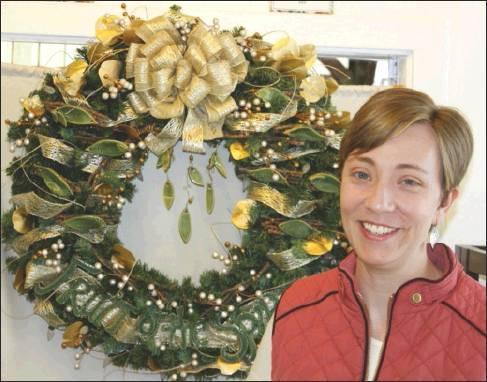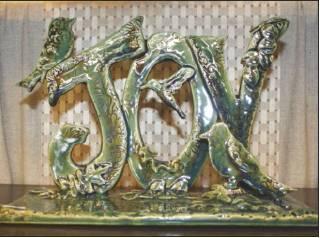Pottery as art: locally-made and handcrafted
Here’s a good definition of happiness: being able to make a living doing what you love to do.
That describes Cristi Clyburn. Since graduating from Texas State in 2006 with a degree in English and Art, Cristi has been creating and selling her unique style of pottery. Her parents bought her an electric kiln years ago and she has been in love with pottery ever since.
With cheap, mass-produced pottery widely available, selling hand-crafted works of art has its challenges. “This is what I do for a living,” says Cristi. ”I’m not going to lie. It’s hard. Every day is different. Every day is a challenge. I hope it’s not a dying art because it is becoming increasingly rare. But it’s hard to make a living at it.”
When you walk into Cristi’s gallery-like Open Window Studio at Wimberley Market Days, the first thing you notice is that Cristi likes green. Boy, does she like green. Booth 203 is chockfull of her creations — mugs, bowls, trays, ornaments, wreaths and more. The one thing they have in common is the color green. The one-of-a-kind, handmixed glaze gets its rich color from copper and zinc.
“I used to do a blue, a purple and a red, but I found myself fighting those colors a lot,” she says. “I find green very soothing. The glaze is very soothing, and it’s also very beautiful.”
While everything is a shade of green, there are hints of other colors mixed in. Sometimes the green fades to blue. Sometimes there’s a metallic glint. “A friend of mine saw the bluegreen color of the glaze and exclaimed, ‘It’s the colors of Jacob’s well,’ “ recalls Cristi.
The artist explains that her glaze can be very temperamental. The outside temperature or how quickly she applies the glaze can have an impact on the color she gets at the end.
Oven and microwave safe
Cristi produces stoneware which is safe for the oven, microwave and dishwasher. She avoids fancy terms like ceramics to describe her creations. “I call it pottery because it’s fundamental. It’s useful.”
A large platter might take six weeks to complete. She has to create the piece from clay, apply the details — such as hummingbirds, dragonflies and leaves — put on the glaze and fire the kiln up to around 2,000 degrees. The drying process takes a while and changes in the weather, such as a drop in humidity, can have a big impact.
Prices at her gallery range from around $20 to several hundred dollars. Creations come and go. “Sometimes I say to myself ‘you know, I just don’t want to do this any more. I just want to take a break (from that item),” Cristi says. In the future, she hopes to come out with a line of jewelry.
Some foreign-made products have given pottery a bad rap because of the lead-tainted, toxic glaze that is used. “I use pretty much straightforward things in my glazes,” says Cristi. “Nothing is risky. Everything is tried and true.”
Cristi’s pottery is available at shops in Fredericksburg, Round Top and at a gallery in Colorado, but her largest collection is at Market Days. The Ply Yarn knitting store on the Square also carries Cristi’s handmade yarn bowls. More and more, she is finding that on-line sales are becoming a bigger part of her business.
Aside from the various styles of mugs, her most popular item is the Trio Bowl, a set of three bowls fused together that are perfect for storing small items like keys and pocket change or organizing the fixings for tacos.
Part of a tradition
Lately, she has concentrated on themed collections. The Dragonfly and Hummingbird collections are self explanatory. The Serendipity Collection features items that “just kind of turned out that way.”
Many customers come in to buy a piece that becomes part of a family tradition. A serving platter might come out at Easter or a pottery wreath is brought out at Christmas. “To be part of something like that is very, very special. It’s such an honor,” she says.
“I have scripture on much of my work. I want my work to tell people that God loves them.” Cristi says.
Over the years, Cristi’s skill level has evolved. She has added techniques and, she says, makes fewer mistakes. That means that there are fewer, slightly flawed items ending up on the sale table.
Her pottery is produced at a small home studio where a rescue hound dog and a cat keep her company. For the first five years, the 20 by 20 studio had no windows and sometimes got a bit warm during the summer months. She finally got some windows.
Operating your own business means more than just creating pottery. Cristi has had to learn how to run the website, promotion, sales, bookkeeping, and all the things that keep a small business going.
Cristi Clyburn is doing what she wants to do. She’s happy. The rest of us should be green with envy.
Did you know?
— Ancient Egyptians made kilns to fire their clay pots. — Ancient Greek vases are highly valued for form and decoration. — In medieval times sand was mixed with clay to make cooking pots strong enough to be placed over an open fire. — Around the middle of the thirteenth century, German potters started to produce stoneware. This pottery was made from finer clays and fired at a higher temperature than earthenware. — Light, transparent porcelain was first produced in China.



